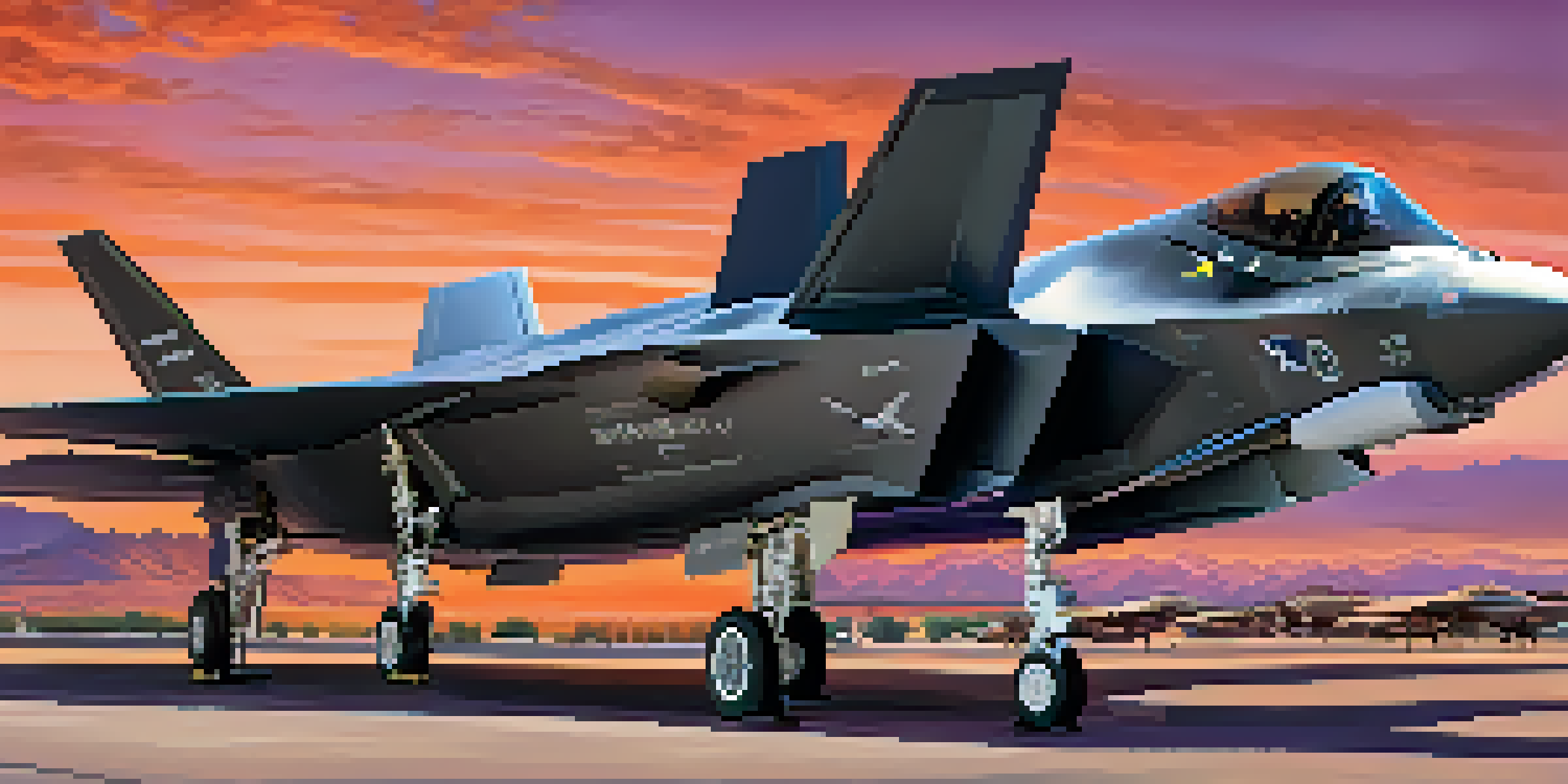Historic Military Bases: Luke Air Force Base in Phoenix

Introduction to Luke Air Force Base and Its Legacy
Luke Air Force Base, located in Phoenix, Arizona, has a storied history that dates back to World War II. Originally established in 1941, it was named in honor of Lieutenant Frank Luke, a pioneering aviator known for his bravery and skill. Over the decades, the base has played a crucial role in training pilots and supporting military operations.
The strength of the military is not just in its technology or its training but in its connection to the community it serves.
As one of the largest air bases in the United States, Luke has been instrumental in the development of advanced fighter aircraft. It has hosted numerous squadrons and has become a premier training center for fighter pilots, particularly those flying the F-16 Fighting Falcon. This legacy of training excellence continues to this day, contributing significantly to the U.S. Air Force's operational readiness.
Luke AFB's significance extends beyond its training programs; it also serves as a vital community hub. The base has fostered strong ties with the local community, hosting events and providing support to military families. This connection has helped solidify its place not only in military history but also in the hearts of Phoenix residents.
Key Historical Events at Luke Air Force Base
Throughout its history, Luke Air Force Base has witnessed several pivotal moments that shaped its identity. One notable event was its activation during World War II, where it quickly ramped up to train thousands of pilots for combat. This surge in activity marked the base as a key player in the war effort, helping to secure air superiority for the Allies.

The Cold War era brought further changes to Luke, as the base adapted to new technologies and the need for advanced pilot training. The introduction of jet aircraft and the establishment of specialized training programs highlighted Luke’s importance during this tense period in history. The base became a hub for innovation, ensuring that pilots were well-prepared for the challenges of modern aerial combat.
Legacy of Training Excellence
Luke Air Force Base has a rich history of training pilots, notably for advanced aircraft like the F-16 and F-35, ensuring operational readiness for the U.S. Air Force.
In more recent years, Luke has continued to evolve, embracing advancements in aviation technology. The transition to training pilots on the F-35 Lightning II underscores its commitment to maintaining a competitive edge in the air. This commitment to modernization ensures that Luke AFB remains a critical player in the U.S. Air Force's future.
The Role of Luke AFB in Modern Military Training
Today, Luke Air Force Base stands as a cornerstone of pilot training for the United States Air Force. With a focus on the F-35 program, the base is shaping the next generation of fighter pilots who will defend U.S. airspace. The training here is rigorous, combining advanced simulators with real-world flying experiences to ensure comprehensive preparation.
Sustainability is not a choice, it is a necessity for the future of our planet and our military operations.
Luke’s training programs not only emphasize technical skills but also focus on teamwork and decision-making under pressure. Pilots are trained to handle complex scenarios, fostering a culture of resilience and adaptability. This holistic approach is crucial, especially as aerial combat becomes increasingly sophisticated and multifaceted.
Moreover, the collaborative environment at Luke AFB allows for joint exercises with other branches of the military and international allies. These partnerships enhance interoperability and strengthen global defense strategies, making Luke a vital player in international military relations.
Community Engagement and Support Initiatives
Luke Air Force Base has a strong commitment to community engagement, recognizing the important role that local residents play in supporting military families. The base hosts various events throughout the year, including open houses, airshows, and family days, allowing the community to connect with servicemen and women. These events not only showcase the capabilities of the Air Force but also promote understanding and appreciation for military life.
Additionally, Luke AFB collaborates with local organizations for outreach programs aimed at enhancing the quality of life for military families. These initiatives may include educational support, career fairs, and mental health resources, demonstrating the base's dedication to its personnel and their loved ones. By fostering a supportive environment, Luke strengthens its ties with the community.
Community Engagement Initiatives
The base fosters strong ties with the Phoenix community through events and outreach programs that support military families and promote civic pride.
The relationship between Luke AFB and the Phoenix area is mutually beneficial. Local businesses often thrive from the patronage of the base's personnel, while service members gain a sense of belonging within the community. This synergy contributes to a vibrant local culture that honors both military service and civic pride.
Architectural Highlights of Luke Air Force Base
Architecturally, Luke Air Force Base features a mix of historic and modern structures that reflect its evolving mission. The original buildings from the 1940s showcase classic military architecture, with their straightforward designs built for functionality. As the base expanded, newer facilities incorporated contemporary designs, emphasizing efficiency and technology.
One of the standout structures is the Luke AFB flight line, where aircraft are maintained and prepared for training missions. This area is not only a hub of activity but also a testament to the engineering advancements in modern aviation. The blend of old and new facilities provides a unique backdrop that tells the story of military evolution over the decades.
Furthermore, ongoing renovations and upgrades ensure that Luke remains at the forefront of military readiness. These improvements not only enhance the operational capabilities of the base but also ensure a safe and welcoming environment for all personnel. As Luke AFB continues to grow, its architectural landscape will likely evolve, mirroring the dynamic nature of the Air Force itself.
Environmental Efforts at Luke Air Force Base
In recent years, Luke Air Force Base has prioritized environmental sustainability alongside its military operations. Recognizing the importance of protecting natural resources, the base has implemented various initiatives aimed at reducing its ecological footprint. These efforts include energy conservation measures, waste reduction programs, and habitat restoration projects.
One example of Luke's commitment to sustainability is its use of renewable energy sources. The base has installed solar panels that generate a significant portion of its energy needs, showcasing a forward-thinking approach to energy management. This not only reduces reliance on fossil fuels but also sets a positive example for other military installations.
Commitment to Environmental Sustainability
Luke AFB prioritizes environmental efforts, implementing initiatives such as renewable energy use and habitat restoration to reduce its ecological footprint.
Moreover, Luke AFB actively engages its personnel in environmental stewardship programs. By fostering a culture of responsibility, the base encourages service members to participate in activities like clean-up events and conservation workshops. These initiatives reinforce the notion that military readiness and environmental health can go hand in hand.
Looking Ahead: The Future of Luke Air Force Base
As we look to the future, Luke Air Force Base is poised to remain a vital asset to the U.S. Air Force and the local community. With ongoing advancements in technology and training methodologies, the base will continue to adapt to the changing landscape of military aviation. This adaptability ensures that Luke will train pilots who are ready to meet the challenges of tomorrow's air combat.
In addition to technological advancements, the base is likely to further strengthen its community partnerships. As the relationship between military and civilian sectors deepens, Luke AFB will continue to foster a sense of unity and shared purpose. This collaboration is essential for building a resilient community that supports both service members and local residents.

Ultimately, Luke Air Force Base stands as a testament to the enduring spirit of military dedication and community support. As it continues to evolve, this historic base remains a symbol of the strength and commitment of the U.S. Air Force, ensuring that it will play a crucial role in the defense of our nation for years to come.